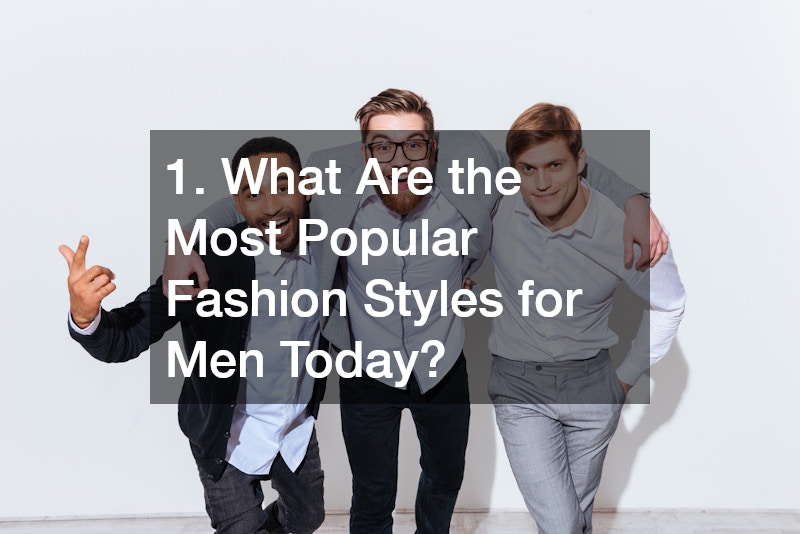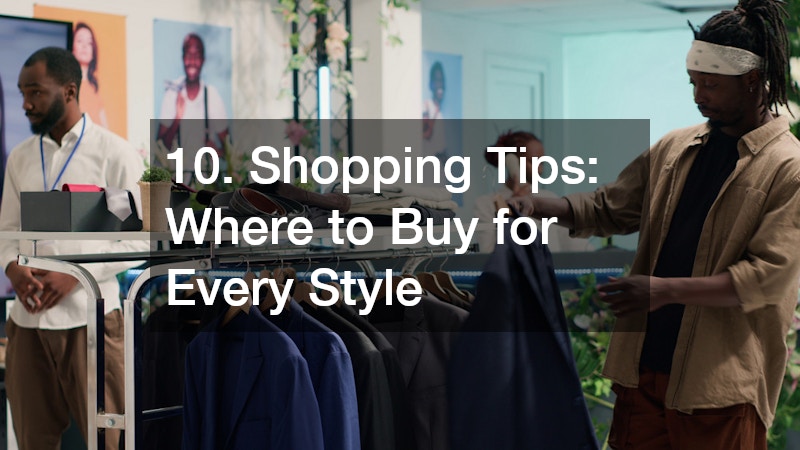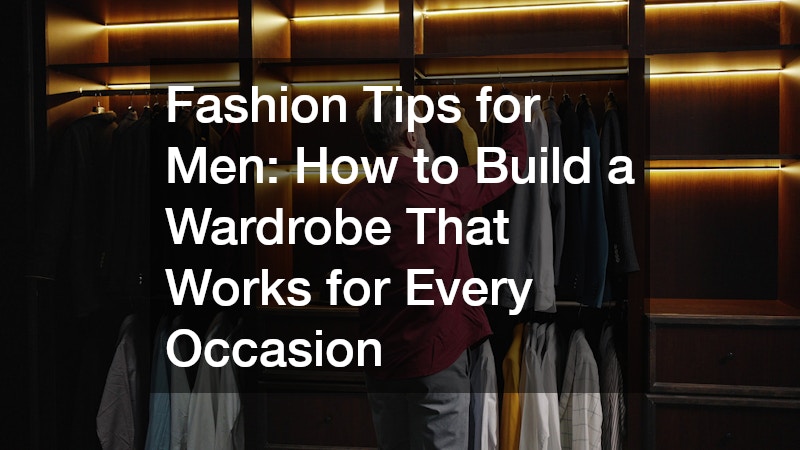
In today’s fast-paced and visually driven world, fashion is no longer a mere afterthought for men. It’s a tool for self-expression, a form of confidence, and a reflection of personality. Whether you’re heading to a boardroom meeting or catching up with friends, how you dress says a lot about who you are.
This guide is designed to walk you through the different fashion styles for men, helping you identify your signature look and build a wardrobe that aligns with your lifestyle and goals.
Why Does Finding Your Fashion Style Matter?
Before diving into the details of individual fashion styles, let’s understand the “why.” Choosing a style isn’t just about looking good—it’s about feeling confident and authentic in what you wear.
When you find a fashion style that resonates with your personality, your clothes stop being just fabric. They become a communication tool. A well-developed personal style simplifies shopping, speeds up your morning routine, and makes you stand out without trying too hard.
Some men find their style early in life, while others evolve over time through experimentation. Either way, this guide will help you decode the fashion landscape and find what fits you best.
1. What Are the Most Popular Fashion Styles for Men Today?

Men’s fashion has never been more diverse. From traditional tailoring to edgy streetwear, the range of styles is broad, and each comes with its own rules and attitude.
Here are the top fashion styles you should know:
- Classic/Timeless Style: Think structured blazers, crisp white shirts, and chinos.
- Casual Style: T-shirts, jeans, sneakers—effortless, laid-back outfits.
- Streetwear Style: Hoodies, graphic tees, sneakers, and bold accessories.
- Preppy Style: Polo shirts, khakis, loafers, and pastel tones.
- Minimalist Style: Clean lines, neutral tones, and quality over quantity.
- Business Formal: Tailored suits, dress shoes, and understated accessories.
- Rugged/Workwear Style: Denim jackets, flannel shirts, boots, and utility pants.
- Athleisure Style: Joggers, athletic sneakers, performance fabrics.
Each of these styles represents a certain lifestyle and attitude. Understanding their core elements is the first step in finding what works for you.
2. Classic Style: Timeless Elegance That Never Fades
The classic style is the gold standard of men’s fashion. It’s rooted in timeless pieces that are always in vogue, no matter the trends.
Key elements of classic style:
- Well-fitted blazers and sports coats
- Button-down shirts in solid or subtle patterns
- Chinos and tailored trousers
- Leather dress shoes (Oxfords, brogues, loafers)
- Neutral color palette (navy, gray, beige, black)
When to wear it:
- Business casual settings
- Dinner dates
- Events with smart dress codes
Classic fashion is all about investment. Buying fewer, higher-quality pieces that last for years is the hallmark of this style. If you’re someone who values structure, reliability, and elegance, classic may be your go-to.
3. Streetwear: The Bold Expression of Urban Culture
Streetwear has grown from a niche subculture into a global fashion powerhouse. Influenced by skateboarding, hip-hop, and youth culture, this style is defined by comfort, graphics, and attitude.
Must-haves in a streetwear wardrobe:
- Oversized hoodies and sweatshirts
- Graphic tees and logo-heavy clothing
- Distressed or baggy jeans
- High-top sneakers or designer trainers
- Snapbacks, beanies, and crossbody bags
Why it’s appealing:
Streetwear allows for maximum personality and creativity. It often breaks traditional fashion rules and thrives on limited releases and exclusive pieces. If you’re a trendsetter who likes to stand out and follow hype brands, streetwear is your lane.
4. Minimalist Style: Less Is More
Minimalism in fashion emphasizes clean lines, subtle tones, and simple designs. This style is perfect for men who appreciate clarity and modern aesthetics.
What defines minimalist fashion:
- Solid color tees and turtlenecks
- Slim-fit jeans or trousers
- Monochrome layering
- White sneakers or loafers
- High-quality fabrics with minimal branding
This style strips down your wardrobe to essentials. It’s ideal for those who want a clutter-free closet without sacrificing sophistication. It’s also highly versatile—each item can be mixed and matched with ease.
5. The Preppy Style: Ivy League Charm
Originating from American college campuses, preppy fashion is neat, clean, and often colorful. It blends casual and formal elements to create a polished but approachable look.
Key wardrobe staples:
- Polo shirts and button-downs
- Cardigans, vests, and cable-knit sweaters
- Chinos or slim-fit khakis
- Boat shoes or loafers
- Pastel colors and subtle patterns
Who it suits:
If you’re someone who leans toward refined and collegiate looks, the preppy style offers endless outfit possibilities. It’s especially great for spring and summer settings.
6. Rugged and Workwear Style: Built for the Outdoors
Inspired by utility, this fashion style features durable clothing often associated with manual labor, outdoor life, and Americana aesthetics.
Essential pieces for the rugged style:
- Denim and leather jackets
- Flannel shirts and Henley tees
- Work boots or moc-toe boots
- Carpenter pants or raw denim
- Earthy tones like brown, olive, and rust
This look is both masculine and functional. Perfect for men who enjoy the outdoors, craftsmanship, or simply love rugged aesthetics.
7. Athleisure: Where Comfort Meets Functionality
Athleisure combines athletic clothing with everyday fashion. It’s modern, sporty, and incredibly comfortable—ideal for on-the-go lifestyles.
Your athleisure checklist:
- Joggers or performance shorts
- Moisture-wicking t-shirts
- Track jackets or bombers
- Clean, modern sneakers
- Baseball caps and smart backpacks
Athleisure is ideal for guys who hit the gym, love comfort, or want to stay fashion-forward while running errands or traveling.
8. Different Fashion Styles for Men by Personality Type
Your personality plays a significant role in which fashion style fits best. Here’s a quick breakdown of style recommendations by persona:
- The Professional: Classic or Business Formal
- The Creative: Streetwear or Minimalist
- The Adventurer: Rugged or Workwear
- The Trendsetter: Streetwear or Preppy
- The Fitness Buff: Athleisure
Knowing your personality can help narrow down your fashion choices, especially when building your signature look.
9. How to Discover and Build Your Signature Style
Finding your signature look doesn’t happen overnight. It requires experimentation, inspiration, and self-awareness.
Actionable steps to develop your style:
- Audit your closet: Identify what you wear most often and feel best in.
- Gather inspiration: Use Pinterest, Instagram, or fashion blogs.
- Start with the basics: Nail down core wardrobe essentials.
- Experiment slowly: Try new styles piece by piece, not all at once.
- Invest in fit: Clothes that fit well will always look stylish, no matter the aesthetic.
Remember: your signature style should reflect your life, not someone else’s. Dress for your body, your job, and your goals.
10. Shopping Tips: Where to Buy for Every Style

Building your wardrobe doesn’t need to be expensive. Each fashion style can be achieved on any budget with the right approach.
Best places to shop by style:
- Classic/Business: Banana Republic, J.Crew, SuitSupply, Brooks Brothers
- Streetwear: Supreme, Kith, BAPE, Urban Outfitters, ASOS
- Minimalist: Uniqlo, COS, Everlane, MUJI
- Preppy: Ralph Lauren, Tommy Hilfiger, Vineyard Vines
- Rugged: Levi’s, Carhartt, Filson, Timberland
- Athleisure: Nike, Lululemon, Adidas, Gymshark
Don’t forget to visit thrift stores, outlet malls, and online marketplaces for great finds at lower prices.
11. Common Mistakes to Avoid When Trying New Fashion Styles
Transitioning into a new style can be tricky. Here are some pitfalls to avoid:
- Copying others exactly: Be inspired, but don’t imitate.
- Ignoring fit: Baggy or tight clothes can ruin even the best outfits.
- Over-accessorizing: One or two standout pieces are enough.
- Mixing too many styles at once: Master one before blending others.
- Forgetting the shoes: Shoes can make or break your look.
Avoiding these mistakes ensures your style feels intentional and polished.
12. Evolving Your Style Over Time
Your style today may not be the same a year from now—and that’s okay. As you grow, so should your fashion. Stay open to change and continue refining your wardrobe as your tastes, lifestyle, and career evolve.
Pro tips:
- Update seasonal pieces annually
- Let go of what you no longer wear
- Stay informed about fashion trends, but don’t feel pressured to follow them
- Develop a “uniform” that works for most occasions
Fashion is a journey, not a destination. Treat it as a way to express your best self every day.
How to Mix Different Fashion Styles Without Looking Confused
Blending fashion styles is an advanced but rewarding move that can make your outfits truly unique. The key is balance—don’t overdo it. For example, you can pair a classic blazer with distressed jeans for a smart-casual fusion or wear minimalist sneakers with streetwear-inspired joggers for a clean, urban vibe.
The secret lies in choosing one dominant style and adding subtle elements from another. Stick to a cohesive color palette, and use accessories like watches, bags, or hats to tie everything together. Mixing different fashion styles for men successfully showcases creativity and confidence, setting you apart without looking mismatched or disorganized.
Fashion Styles for Men by Occasion: Dress Right Every Time
Dressing appropriately for different occasions ensures you feel confident and makes a strong impression. Each setting has its own expectations, and matching your outfit to the event can elevate your presence. Here’s a quick breakdown of fashion styles suited for common occasions:
- Business Meetings
- Opt for classic or business formal styles
- Tailored suits, dress shirts, leather shoes
- Neutral tones like navy, gray, or black
- Casual Outings
- Casual or minimalist styles work best
- T-shirts, jeans, sneakers, and light jackets
- Focus on comfort and clean fits
- Weddings & Formal Events
- Stick to business formal or modern classic looks
- Suits or tuxedos, depending on the dress code
- Polished shoes and subtle accessories
- Date Nights
- Try smart casual or preppy styles
- Blazer over a fitted shirt, chinos, or dark jeans
- Stylish loafers or minimalist sneakers
- Vacations & Travel
- Lean into athleisure or rugged styles
- Joggers, breathable fabrics, and versatile layers
- Prioritize comfort without compromising style
- Gym & Fitness
- Stick with athleisure
- Moisture-wicking shirts, joggers, or shorts
- Supportive athletic sneakers and a clean gym bag
Understanding fashion by occasion helps you look effortlessly stylish while respecting the context of every environment.
Conclusion: Embrace the Style That Speaks to You
With so many different fashion styles for men, there’s truly something for everyone. Whether you’re into sleek minimalism, bold streetwear, rugged layers, or timeless tailoring, the key is to find what feels right for you.
Start small, stay authentic, and enjoy the process. Your wardrobe isn’t just clothing—it’s an extension of who you are.

